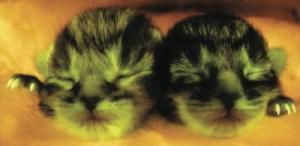On science blogs this week: Catty
HUMAN ANCESTRY: FRIENDS WITH BENEFITS? Most fascinating/puzzling/discombobulating news of the week is indubitably the assemblage of Science papers on Australopithecus sediba, the possibly 2-million-year-old possible human ancestor.
Among other things the topic is a fine illustration of the blessings of blogging: we can avail ourselves of comments from scientists with specialized knowledge, a breadth of expertise never before vouchsafed science writers and other outsiders.
Most notable in this case is the blog of paleoanthropologist John Hawks, who has been writing about this find almost since it was found in 2010, although he was not among the finders. At this URL, find his collection of several links to his past posts on A. sediba.
Hawks has visited the site of the find in South Africa. He also is hosting the Malapa Soft Tissue Project, an open science attempt to discover whether soft tissue from A. sediba exists. (Something that is maybe possibly perhaps skin was discovered at the site.) The effort is, among other things, "a true experiment in whether paleoanthropology could be done as open science."
Hawks's posts tend to assume that you already know a lot about A. sediba. If you don't, here are some helpers to read before you tackle the Hawks material:
A fine introduction by another anthropologist, Krystal D'Costa, can be found at her SciAm blog Anthropology in Practice. Among her subjects is A. sediba's female pelvis, which is somewhat like ours. That's odd, because the hypothesis about the unique shape of the human pelvis is that it is built to accommodate a big-brained fetus. But A. sediba was small-brained.
At Dienekes' Anthropology Blog, anthropologist Dienekes Pontikos does not discuss the find so much as complain that the Science papers are sequestered behind a pay wall although the work appears to have been underwritten by taxpayers around the world. He plugs the Malapa Soft Tissue Project too.
The pay-wall problem is not going away despite the Public Library of Science and other new open-access journals. But another virtue of blogs is that you can learn much of what you want to know about a new piece of research from their summaries.
Several of our best science writers have also explicated. For example, find a fine summary at Carl Zimmer's The Loom.
Faye Flam of the Philadelphia Inquirer explains the sex angle and why A. sediba might be one of our ancestors at her blog Planet of the Apes.
Interbreeding also interests Blair Bolles at Babel's Dawn. Also neurologist Steven Novella at Neurologica.
It's too much to hope that the Malapa Soft Tissue Project, even if successful, could yield DNA. DNA is breakable stuff, and the idea that it might survive for going on 2 million years is no doubt a fantasy. But what a lovely fantasy it is that we might be able to find traces of A. sediba in our own genomes, just as we have found evidence that some of our ancestors were Neandertals.
Not to mention chimps. Which no doubt many of us prefer not to mention.
THE POLITICS OF THE HPV VACCINE. Science and medicine enter what the MSM call the political arena infrequently, but maybe instead of decrying that fact, as has been our wont, we should see it as a blessing. Because when the gladiators are politicians, science hardly ever comes off looking good.
I speak, of course, of this week's political fracas over the vaccine that prevents infection by the human papilloma virus. This is the virus that causes cancer of the human cervix, and cervical cancer is the sexually transmitted disease that is often fatal. The prevalence of cervical cancer (and other HPV diseases, some of which even affect men) is due to drop, however, because around 35 million doses of the vaccine have been administered so far, many of them to young girls.
The flap began in an attempt to bash Republican presidential candidate Rick Perry, who backed a state program to vaccinate female sixth graders when he was governor of Texas. This bash was legitimate even if you thoroughly approve of vaccinating youngsters before (we hope) they start having sex. That's because the vaccine's maker, Merck, had contributed some $30,000 to Perry's campaign (although Perry fabulated it at $5000 only). Tellingly, a former Perry staffer was a lobbyist for Merck.
Michele Bachmann to the rescue! Another GOP presidential candidate, Bachmann started off in the right direction against Perry, emphasizing the Merck connection. But she wandered off into a fabulation of her own, that the HPV vaccine causes mental retardation.
This charge has drawn a blast of outrage from, among others, both the American Academy of Pediatrics and two bioethicists who have put their money where their mouths are. One is the University of Pennsylvania's Arthur Caplan (full disclosure: an old friend), who is wagering $10,000 that Bachmann cannot produce the mentally retarded vaccine victim. Scott Hensley has details at the NPR health blog Shots.
The larger point is that the news is now all about Bachmann and whether the HPV vaccine causes mental retardation. Perry's potentially queasy relationship with Merck, a grown-up genuine issue, is no longer of media interest.
The best blog summary comes from Seth Mnookin at The Panic Virus, not surprising since he wrote the book on the anti-vaccine movement and its chief claim, that standard childhood vaccines cause autism. Many links.
Also of interest:
Babbage, at The Economist, describes a new study showing that IUDs seem to reduce a woman's risk of cervical cancer substantially — perhaps because IUDs cause inflammation, which might stimulate an immune response that fights off HPV.
J.B. Handley at Age of Autism, an antivax site, whose post describes the alleged dangers of the vaccine, Gardasil, and displays a photo of the gravestone of a girl allegedly killed by the vaccine. Many other anti-vaccine screeds on this site.
Find counterpoint in graphical data on the HPV vaccine's safety record and cervical cancer statistics by David McCandless at Information is Beautiful.
GLOWING REVIEWS FOR GREEN FLUORESCENT CATS. I have vowed to myself not to fall into the banality of female blogger writing about cats. I've lasted nearly two years, pretty restrained for a blogging lifelong cat-lover. But this week's news about putting green fluorescent protein into cats — the stated point of the research was to study AIDS — is irresistible. That's not so much because of the news, but because of the photos. These are not cute kitties. They are ... unnerving.
Other bloggers also succumbed:
Emily Singer at the Technology Review Editors Blog, pointed out that this was the first time cats had been genetically engineered by inserting genes into their eggs, doubtless why the paper was published in Nature Methods. The usual method is cat cloning.
At Discoblog, Veronique Greenwood hewed to the cats-are-always-adorable line but subverted it by publishing several of the unearthly pix. She described how the researchers genetically engineered the cats, but she also called the (now-common) use of GFP as a marker to track other genes "wacky." She also failed to emphasize the genetic engineering method's novelty in this species.
Connor Bamford at Rule of 6ix gives us more detail about feline AIDS, about the genetic engineering procedure and its effects on FIV infection. He doubts that the green cats will be of much use in research on other diseases.
Hannah Waters, blogging at Spoonful of Medicine on Nature Methods's sister site Nature.com, was unable to resist feline puns (The transgenic cat is out of the bag, it's the cat's meow) but was of course concise and excellent on the science and on the transgenic cat's potential as a model organism. Not to be catty, but Waters also succumbed to the adorableness bromide and wanted to know how she could get her own glowing cat. One of the researchers sniffed:
We’re not interested in frivolous applications.
The researchers may not be interested, but you can bet your Puss-in-Boots that some reproductive entrepreneur will be. Too late for this coming Halloween, probably. But wait 'til next year.





